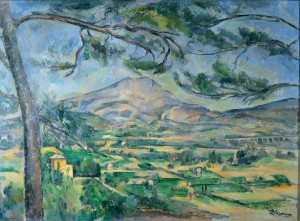Un Secret

……..Mont Sainte-Victoire, Provence
Marc and Anne-Marie
live in the shadow of the Marquis
de Sade’s chateau between
Le Coste and Coustellet
in the hot magic of Provence.
They live like children of wonder
who have no past or future
who laugh at everything
and sing secret songs to the sun.
They make large French furniture
which they sell to tourists;
they call their baker mother;
they linger over dinner
long hours into the night
and only drink the light
red wine made by their neighbors.
There is a place you must see,
says Anne-Marie. C’est un secret,
un mystère, and she leads me
off the dusty road
through a tangle of lavender
and jenever bushes whose berries
smell like gin to a clearing
where an old stone building stands.
Round narrow closed gazebo
made of flat stacked stone
looking like a turret plucked
from a wild castle. Voila! Ici.
What is it, I ask.
Je ne c’est pas. No one knows.
They say it is old. Vraimont ancien.
Inside, two small chambers,
hard clay floors, a fortress for dwarfs
perhaps or a place where
the Romans put you when you laughed
instead of bowing low to Caesar.
But some say it is the place
where the secret names of the gods are kept.
The ancient gods, gods
of this place, the gods of the Luberon
before Jupiter before Jesus
god of Vaucluse, cold flowing goddess
of Ils-sur-le-Sorgue
goddess of vine and grain
and the white old man of Ventoux.
And all around us
outside in the still shivering heat
a chorus of insistent
cicadas, les cigales,
the keepers,
cling to the trees
and chant and repeat
and sing the secret they
overheard dark ages ago,
the unknowable, forgotten names of god.
Featured Art: Mont Sainte-Victoire by Paul Cézanne via Wikimedia Commons
Related Article: How Provence Changed the World of Art
by Barbara Noe Kennedy
“It was all thanks to the revolutionary genius of Aix-en-Provence native Paul Cézanne. On the edge of the quintessential Provençal town of Aix-en-Provence, Mont Ste-Victoire soars more than 1,000m above a vast plain of vineyards, red tile-roofed villages, meandering streams and copses of pines. . . . The Romans achieved their first significant stronghold beyond their empire at this very spot, defeating Cimbrian and Teutonic barbarians in 102 BC. Legend dictates the name Mont Ste-Victoire (Mount Saint Victory in English) has memorialized that win ever since (the ‘saint’ was added by medieval Christians).”
